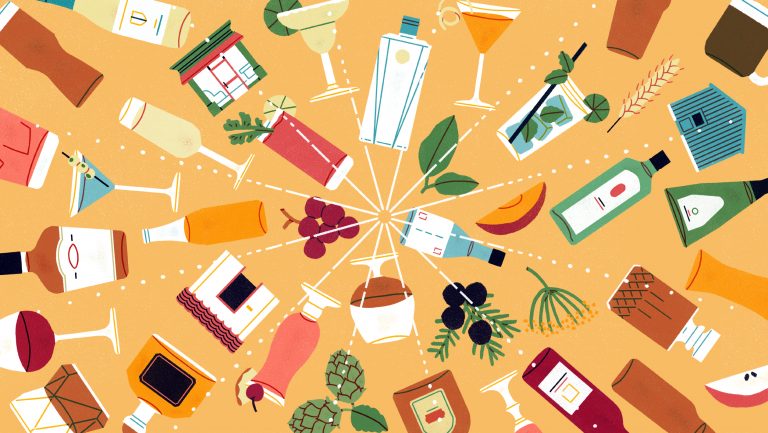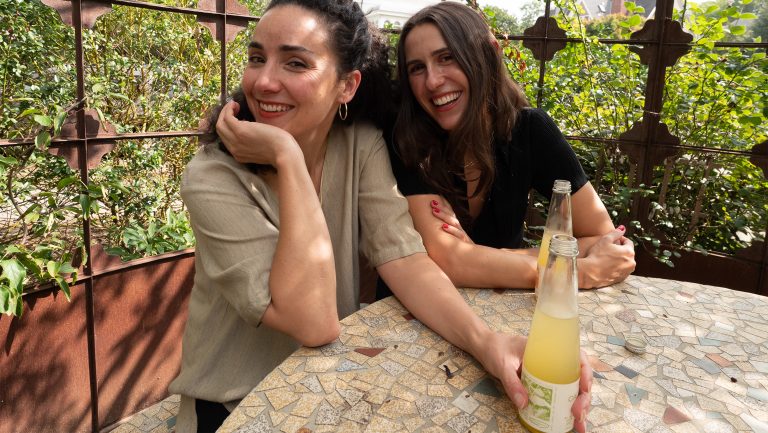Ready-to-drink (RTD) cocktails have become one of the beverage industry’s biggest success stories in recent years. A foundation for growth was laid pre-pandemic as mainstream players, craft brands, and even bartenders created premium RTD cocktails and put them in single-serve cans, and the category started to take off by 2017 thanks to a combination of convenience, higher quality, and wider flavor variety. Then, the pandemic pressure cooker catapulted the segment into overdrive.
According to Mintel data, total volume sales of spirits-based RTD cocktails increased 226 percent from 2016 to 2021, making the category one of the fastest-growing segments across beverage alcohol. In 2021, nearly 50 percent of adults over 22 years old reported drinking RTD cocktails, up from 40 percent in 2018.
Now, with consumers out from under lockdowns and restricted gatherings, the immediate need for attributes like portability and bar-level cocktail quality at home has diminished—yet consumers aren’t abandoning their ready-to-drink darlings. Rather, even more new releases are hitting the market, capitalizing on wellness, packaging, and flavor trends. Consumers seem to have an endless appetite for RTD cocktail innovations—and it’s likely to propel the category for years to come.

Don’t miss the latest drinks industry news and insights. Sign up for our award-winning Daily Dispatch newsletter—delivered to your inbox every week.
An Unexpected Trajectory
While news of the RTD cocktail’s soaring success seems obvious now, it wasn’t always that way. A Mintel report from December 2017 cited an expected growth rate of 24 percent for spirit-based RTD cocktails from 2017 to 2022—a number that the category far outpaced.
According to off-premise data from NielsenIQ—which measures malt-based RTD beverages like hard seltzer, spirits-based RTD options, and wine-based RTD products as one large ready-to-drink category—spirits-based, ready-to-drink cocktails led growth across the $9.6-billion ready-to-drink category in both 2020 and 2021. But it’s not just the consumer demand for RTD cocktails that has changed—it’s the market itself. Though the ready-to-drink cocktail category has existed for decades—in fact, ready-to-drink Club Cocktails by Heublein Spirits were sold before Prohibition—it’s only in the past five to seven years that new brands emerged to spark the shift towards high-quality RTD cocktails.
The mid-2010s also marked the beginning of a shift towards single-serve, canned RTD cocktail formats, pioneered by brands like Cutwater Spirits, which quickly became known for its wide range of canned cocktails and was acquired by Anheuser-Busch in 2019. Though RTD cocktails are sold in a spectrum of formats, from bag-in-box packaging to large- and small-format bottles alike, single-serve cans have since become the norm among new releases in the category.
“When we talk about alcohol, we talk about how consumers are looking to experience new flavors. They’re also looking for convenience, a premium experience, and a wellness element,” says Kayleigh Theriault, the beverage alcohol thought leadership manager for Nielsen IQ. “Ready-to-drink options really hit on all of these consumer drivers at once.”
Then came the impact of COVID-19 lockdowns, when consumers had little choice but to either learn to make cocktails themselves or embrace RTD cocktail options. But even as restrictions have dissipated, demand for ready-to-drink cocktails has continued to expand.
“At Pernod Ricard … convenience is king when it comes to ready-to-drink,” says Natalie Accari, the vice president of RTDs and convenience for Pernod Ricard, who notes that the company’s brands exclusively produce RTD cocktails in single-serve formats for exactly this reason. “Consumers are looking for more convenient options in everything that they’re doing. As a result, we’re really focused on continuing to drive availability so we can put as many cans in consumers’ hands as possible across the country.” Pernod Ricard recently launched ready-to-drink cocktails under the Absolut, Malibu, and Jameson brands—just a few of the many traditional spirits brands that have gotten into the RTD cocktail space.
Though there’s no longer an intensified need for convenience, portability, and the perceived “low-touch” safety of canned formats suited to individual consumption, the discoveries consumers made over the past two years have persisted—and have allowed RTD cocktails to become a solid alternative to canned mainstays. Where beer—and later, hard seltzer—cans once dominated coolers at sporting events, picnics, and parties, the modern RTD cocktail renaissance is now bringing cocktails into those spaces.

Finding Inroads On-Premise
RTD cocktail sales have largely been geared towards retail, with consumers bringing ready-to-drink cocktail options home as an alternative to keeping their bar carts stocked. Interestingly, this is a reversal of traditional beverage alcohol sales trends.
“A lot of the innovation that we see within beverage alcohol begins in the on-premise and then kind of flows into off-premise, but RTDs were a little bit different … in that they launched really, really fast and heavily in the off-premise,” says Theriault. “Now, over the past couple of years we’ve seen them make their way into the on-premise.”
On-premise operators had already begun incorporating RTD cocktails into hospitality venues where staffing and stocking a full bar might not make sense, such as stadiums, theaters, hotels, and airplanes. Some bars launched their own ready-to-drink options as revenue drivers and brand builders amidst pandemic closures and have continued to find value in extending their restaurants’ offerings through bottled or canned cocktails.
But amidst today’s staffing shortages and budgetary constraints, even more restaurants and bars are embracing the advantages RTD cocktails can offer. According to marketplace data from Provi (the parent company of SevenFifty Daily), which has a largely on-premise user base, spirits-based, RTD cocktails are gaining ground over other ready-to drink options, like hard seltzer. Within the larger RTD category, which on Provi includes all wine-, beer-, and malt-based ready-to-drink beverages, market share for pre-mixed cocktails has grown to 31.2 percent over the past 12 months, versus 21.4 percent over the 12 months prior.
“It’s a quick pour-and-serve from beverage carts or poolside bars, beach bars, and patios,” says Bronya Shillo, the founder and CEO of Fishers Island Lemonade, who is a former bartender. “We’re not trying to take away drink orders, but to help speed up the process so then the bartender can go and take the time to make their handmade cocktails without being in the weeds.”
What’s Driving Continued RTD Cocktail Success?
Interestingly enough, as single-serve cans have become more mainstream within the RTD cocktail category, producers are now innovating outside of this format. RTD cocktails are now being released in pouches, bottles, ice pops, plastic balls, and beyond. Brooklyn spirits brand St. Agrestis launched a 1.75-liter, bag-in-box “Negroni Fountain” in 2020, which quickly took off.
The range of packaging formats—and product styles—allows the ready-to-drink category to appeal to a wide cross-section of drinkers. “The consumer who is buying a gallon of Jose Cuervo Margarita ready to drink is not usually the same consumer who’s buying craft canned cocktails,” says Alex Masanotti, the head buyer at Super Buy-Rite in Jersey City, New Jersey, which has seen triple-digit sales growth of RTD cocktails since 2019. “That said, you have all of these products coexisting and all doing well in a range of formats from cans to bag-in-box. It’s really exciting.”
Flavor innovations and exploration are also continuing to drive growth for RTD cocktails. Vodka and tequila continue to dominate new RTD cocktail releases, according to data collected between 2019 and the first half of 2021 by IWSR Drinks Market Analysis, driven by popular Margarita, vodka-soda, and hard seltzer-like flavors. (According to 2021 off-premise data from NielsenIQ, which divides its spirits-based RTD category by products marketed as hard seltzers versus those marketed as cocktails, spirits-based seltzers led growth at 142 percent while spirits-based cocktails expanded by 115 percent.) But consumers are also branching out into other classic cocktail options, like Mai Tais, Mojitos, Old Fashioneds, and beyond.
“The consumers that are traditionally drinking these products are looking for something new and different,” says Theriault.
If there’s a consensus to be had across producers, it’s to focus on premium ingredients and flavors—whether the end product is a simple riff on a vodka-soda like Absolut’s Lime and Cucumber Soda or a more complex option like Tip Top’s Bee’s Knees. “In the beginning it was so challenging,” says Shillo, who has helmed Fishers Island since its founding in 2014. “We were selling a high-priced canned cocktail and there was no category at the time.”

Modern, premium RTD cocktails often have to fight preconceived notions that pre-mixed cocktails are low-quality, says Ali Schmidt, a cofounder of Zuzu, which launched in November 2020 and specializes in RTD cocktails made with simple ingredients like organic agave spirit, fruit juice, and sparkling water. “As we were doing R&D, the concept of the ‘RTD graveyard’ kept coming up,” she says. “People had been trying RTDs, but so many of them tasted artificial and fake that these consumers ended up having this RTD graveyard on the shelf of cans they wouldn’t drink. So we really wanted to solve that problem.”
Zuzu, which lists its ingredients clearly on labels, is also an example of how RTD cocktail brands are appealing to an increasingly health-conscious consumer base through marketing and packaging. The recently launched Faux Pas line of canned cocktails, a partnership between millennial-targeted media company Betches and Spirit of Gallo, highlights its wellness aspects as well, including the use of “real vodka or real tequila” for its gluten-free products. “People really want something that’s healthy and better for them,” says Schmidt. “They want a real spirit that tastes good and uses fresh and whole ingredients. I think once people taste it, they realize this is a possibility and that the category is here to stay.”
A Long Runway for Growth
With increasing competition in the RTD cocktail space and signs of plateauing interest among other recent blockbusters like hard seltzer, some have questioned whether ready-to-drink cocktails can really sustain the level of growth they’ve commanded in the past. But industry experts seem to believe that RTD cocktails are poised to continue expanding.
“Everything indicates that this category has a very long runway for growth, and we expect the RTD category to double in size by 2025,” says Pernod Ricard’s Accari. “Spirits-based RTDs have been experiencing exponential growth, and we could see the segment hitting 100 million cases per year by 2025.”
Though brands will increasingly vy for shelf space as more players enter the market, the proliferation of choice within RTD cocktails is likely to continue propelling the segment forward, especially because consumers are actively seeking variety in all beverage alcohol categories.
“The opportunities are really just beginning and somewhat endless,” says Shillo. Generational shifts are also poised to support the category: Gen Z, which is just beginning to age into beverage alcohol purchasing, is even more aligned with the convenience-driven, wellness-oriented trends driving RTD cocktail expansion, and nontraditional formats aren’t a barrier to entry.
“Younger people in particular are the ones that are now adopting Zuzu,” says Schmidt, noting many Zuzu customers who were conditioned on beer and flavored malt beverages are now reaching for premium RTD cocktails.
“This is definitely a category that’s going to continue to expand,” says Theriault. “We’re continuing to see a lot of innovation across the brands in this space, from new brands to established brands trying to capture their fair share of this category. We may be approaching maturity in the category, but there is still a lot of room for growth.”
Laura Burgess is a writer based in California’s Sierra Foothills. Her work has been featured in Real Simple, Christie’s Luxury Real Estate Magazine, Vinepair, The Kitchn, and more. She writes about wine, spirits, and the intersection of luxury and the great outdoors. Find her @laurauncorked.
